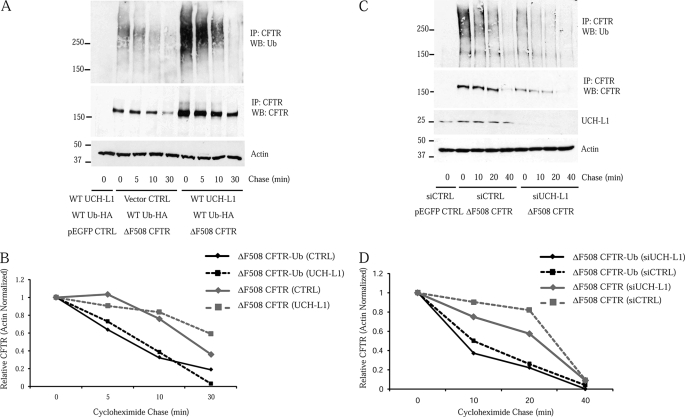FIGURE 9.
The increased pool of ubiquitinated CFTR associated with UCH-L1 expression is enriched in a short-lived and potentially co-translational species. The pool of ubiquitinated ΔF508 CFTR associated with UCH-L1 expression was examined following cycloheximide inhibition of protein synthesis. S9 cells were transfected for 40 h and treated with 100 μg/ml cycloheximide for the indicated chase periods. Following the short chase, the cells were immediately placed on ice, and proteasome inhibitor (MG132) was added at 50 μm to prevent any further degradation. The cells were washed in ice-cold PBS containing 50 μm MG132 and lysed in RIPA. ΔF508 CFTR was immunoprecipitated (IP), and ubiquitinated CFTR was analyzed by blotting for ubiquitin. The first lane represents S9 cells that were transfected with WT Ub-HA, WT UCH-L1, and CFTR control vector. The lack of immunoreactivity confirms the identity of the immunoreactive protein as CFTR-Ub. A, the total cellular pool of ΔF508 CFTR-Ub disappears faster than ΔF508 CFTR, suggesting a nonproteasomal fate for a subpool of ΔF508 CFTR-Ub. ΔF508 CFTR-Ub (top panel) and ΔF508 CFTR (middle panel) were examined by Western blot (WB) following cycloheximide treatment in S9 cells overexpressing WT-Ub-HA ± UCH-L1. B, densitometric analysis of ΔF508 CFTR and ΔF508 CFTR-Ub in A. C, the fate of ΔF508 CFTR-Ub (top panel) and ΔF508 CFTR (second panel) were analyzed following UCH-L1 knockdown in IB3-1 cells. D, densitometric analysis of ΔF508 CFTR and ΔF508 CFTR-Ub levels displayed in C.

